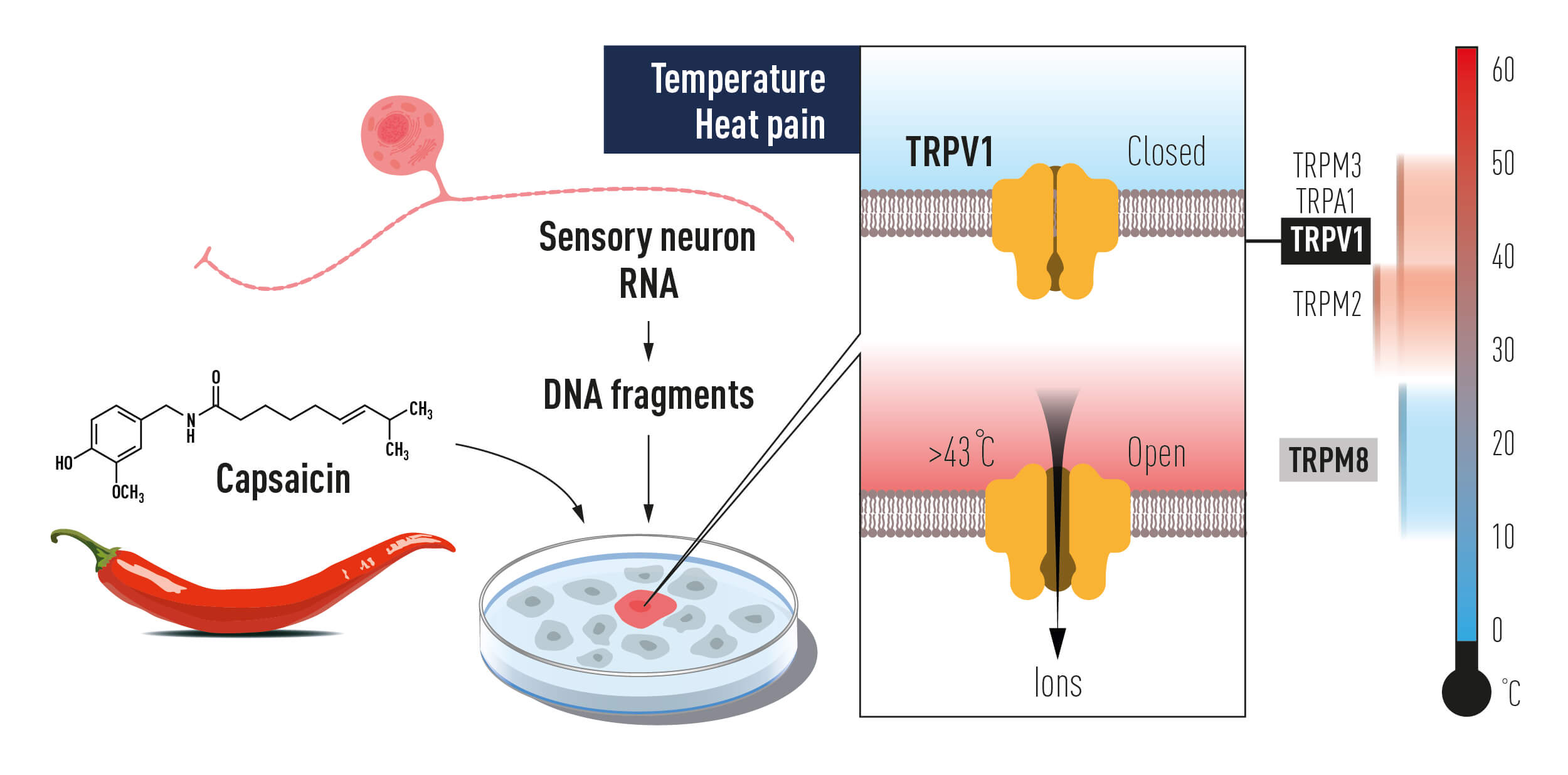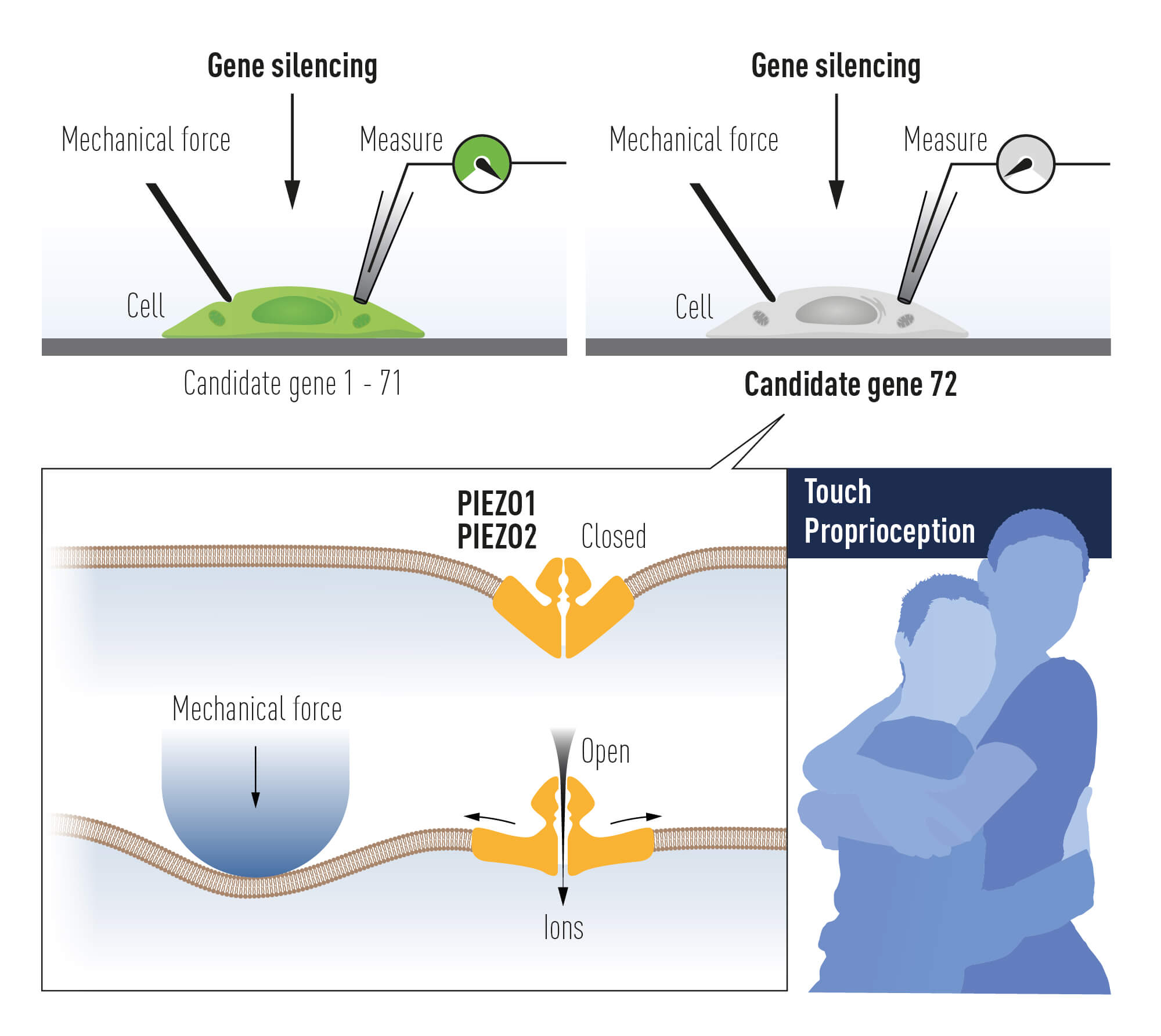(The article below is transcribed from The Nobel Prize)
The Nobel Assembly at Karolinska Institutet has decided to award the 2021 Nobel Prize in Physiology or Medicine jointly to David Julius and Ardem Patapoutian for their discoveries of receptors for temperature and touch.
Our ability to sense heat, cold and touch is essential for survival and underpins our interaction with the world around us. In our daily lives we take these sensations for granted, but how are nerve impulses initiated so that temperature and pressure can be perceived? This question has been solved by this year’s Nobel Prize laureates.
David Julius utilized capsaicin, a pungent compound from chili peppers that induces a burning sensation, to identify a sensor in the nerve endings of the skin that responds to heat. Ardem Patapoutian used pressure-sensitive cells to discover a novel class of sensors that respond to mechanical stimuli in the skin and internal organs. These breakthrough discoveries launched intense research activities leading to a rapid increase in our understanding of how our nervous system senses heat, cold, and mechanical stimuli. The laureates identified critical missing links in our understanding of the complex interplay between our senses and the environment.
Why chili pepper is spicy and hot?
In the latter part of the 1990’s, David Julius at the University of California, San Francisco, USA, saw the possibility for major advances by analyzing how the chemical compound capsaicin causes the burning sensation we feel when we come into contact with chili peppers. Capsaicin was already known to activate nerve cells causing pain sensations, but how this chemical actually exerted this function was an unsolved riddle. Julius and his co-workers created a library of millions of DNA fragments corresponding to genes that are expressed in the sensory neurons which can react to pain, heat, and touch. Julius and colleagues hypothesized that the library would include a DNA fragment encoding the protein capable of reacting to capsaicin. They expressed individual genes from this collection in cultured cells that

normally do not react to capsaicin. After a laborious search, a single gene was identified that was able to make cells capsaicin sensitive (Figure 1). The gene for capsaicin sensing had been found! Further experiments revealed that the identified gene encoded a novel ion channel protein and this newly discovered capsaicin receptor was later named TRPV1. When Julius investigated the protein’s ability to respond to heat, he realized that he had discovered a heat-sensing receptor that is activated at temperatures perceived as painful (Figure 1).
The discovery of TRPV1 was a major breakthrough leading the way to the unravelling of additional temperature-sensing receptors. Independently of one another, both David Julius and Ardem Patapoutian used the chemical substance menthol to identify TRPM8, a receptor that was shown to be activated by cold. Additional ion channels related to TRPV1 and TRPM8 were identified and found to be activated by a range of different temperatures. Many laboratories pursued research programs to investigate the roles of these channels in thermal sensation by using genetically manipulated mice that lacked these newly discovered genes. David Julius’ discovery of TRPV1 was the breakthrough that allowed us to understand how differences in temperature can induce electrical signals in the nervous system.
Research under pressure!
While the mechanisms for temperature sensation were unfolding, it remained unclear how mechanical stimuli could be converted into our senses of touch and pressure. Researchers had previously found mechanical sensors in bacteria, but the mechanisms underlying touch in vertebrates remained unknown. Ardem Patapoutian, working at Scripps Research in La Jolla, California, USA, wished to identify the elusive receptors that are activated by mechanical stimuli.
Patapoutian and his collaborators first identified a cell line that gave off a measurable electric signal when individual cells were poked with a micropipette. It was assumed that the receptor activated by mechanical force is an ion channel and in a next step 72 candidate genes encoding possible receptors were identified. These genes were inactivated one by one to discover the gene responsible for mechanosensitivity in the studied cells. After an arduous search, Patapoutian and his co-workers succeeded in identifying a single gene whose silencing rendered the cells insensitive to poking with the micropipette. A new and entirely unknown mechanosensitive ion channel had been discovered and was given the name Piezo1, after the Greek word for pressure (í; píesi). Through its similarity to Piezo1, a second gene was discovered and named Piezo2. Sensory neurons were found to express high levels of Piezo2 and further studies firmly established that Piezo1 and Piezo2 are ion channels that are directly activated by the exertion of pressure on cell membranes (Figure 2).

The breakthrough by Patapoutian led to a series of papers from his and other groups, demonstrating that the Piezo2 ion channel is essential for the sense of touch. Moreover, Piezo2 was shown to play a key role in the critically important sensing of body position and motion, known as proprioception. In further work, Piezo1 and Piezo2 channels have been shown to regulate additional important physiological processes including blood pressure, respiration and urinary bladder control.
It all makes sense!
The groundbreaking discoveries of the TRPV1, TRPM8 and Piezo channels by this year’s Nobel Prize laureates have allowed us to understand how heat, cold and mechanical force can initiate the nerve impulses that allow us to perceive and adapt to the world around us. The TRP channels are central for our ability to perceive temperature. The Piezo2 channel endows us with the sense of touch and the ability to feel the position and movement of our body parts.
This knowledge is being used to develop treatments for a wide range of disease conditions, including chronic pain
“This discovery has profoundly changed our view of how we sense the world around us”
Immediately following the announcement of the 2021 Nobel Prize in Physiology or Medicine, Professor Abdel El Manira, member of the the Nobel Assembly, spoke to reporter Lotta Fredholm about this year’s awarded discovery. (Video Link)
—————————————————————————————————————-
Taiwanese Scholars Appear to Explain Why Chili Pepper is Spicy and Hot
(The article below is transcribed from the Science Media Center Taiwan)
Jyh-Cheng Chen, research fellow and vice dean at the Institute of Biomedical Sciences, Academia Sinica, indicates that one of the most important contributions made by the two scientists that won the Prize is the discovery of the capsaicin receptor (TRPV1) and the mechanical receptors (Piezo 1 and Piezo 2); it was the first time that these two corresponding sensory receptors were found at the molecular level. The fact that the capsaicin receptor would only be activated at a temperature over 42 degrees has to do with the perception of heat.
Chen explains that an important function of Piezo 1 is to control blood pressure, respiration, and the bladder. Piezo 2 plays a crucial role in the sensory nervous system, including the perception of the mechanical force of senses and the feeling about pain of the subject.
Ho Lin, professor and director at the Department of Life Sciences of the National Chung Tsing University, has also mentioned that feelings such neurological pain and visceral pain are very important to maintaining daily activities. David Giuliani, a professor at the University of California at San Francisco, experimented with capsaicin and found the burning sensation generated by capsaicin and studied further to find the receptor of capsaicin, that is Capsaicin Receptor 1 (TRPV 1).
The study conducted by Ardem Patapoutian was mainly about the mechanical mechanism concerning the perception of touch, such as the suppressive sensation upon bone growth and re-shaping and the blood pressure, etc. These sensors are available in the skin and internal organs so that people can react to the outside world.
Cheng-Chang Lien, dean at the College of Life Sciences, National Yang Ming Chiao Tung University, indicates that there are multiple types of ion channels and some of them can sense the temperature of heat while the others will sense the temperature of cold. Following external stimulation, ion channels experience changes in shape, which is key to the potential variation experienced by peripheral nerves. Lien mentions that it was found later that there were corresponding ion channels to systemic somatosenses. Such fundamental research makes important contributions to the development of painkillers.
Chen adds that the capsaicin receptor is in fact very important to the subject’s perception and reacts to acidity; it reacts also to the mechanical force, except that the mechanism differs from that of receptors Piezo 1 and Piezo 2, indicating that the capsaicin receptor is a multi-functional ion channel. If the Piezo2 receptor is defective, subject senses will experience problems and the subject tends to fall, for example. Chen also adds that the capsaicin receptor may be applied in the future as a treatment option against inflammation and pain.
Such studies are valued among scholars in Taiwan, too. Chun-Hsiang Tan, Assistant Professor at the Graduate Institute of Clinical Medicine, Kaohsiung Medical University, has also been devoted to similar studies. Tan indicates that his study rendered the discovery that the ion channels of another receptor (TRPM 2) had to do with the mechanism to perceive heat and his study was officially released in Nature in 2020.
The four experts in the nation consistently indicate that scientists were unable to determine the mechanism by which temperatures are perceived and the reaction to external stimulation. The two Prize-winning scientists experimented and found that cells were responsive to capsaicin and would experience potential change in response to force to find out these perception mechanisms. It is the most fundamental basis for how we perceive, explain, and interact with the outside world internally and a very important basis for physiological medicine-related studies.
Source:
The Nobel Prize (October 4, 2021); Press release: The Nobel Prize in Physiology or Medicine 2021; The Nobel Prize (October 8, 2021), source https://www.nobelprize.org/prizes/medicine/2021/press-release/
PanSci (October 4, 2021); [2021 Nobel Prize in Physiology or Medicine] Why does it feel hot and tingling? The discovery of temperature and touch receptors; PanSci (October 12, 2021), transcribed from https://pansci.asia/archives/332251
Science Media Center Taiwan (October 4, 2021); press release after the press conference on 2021 Nobel Prize in Biomedicine; Science Media Center Taiwan (October 13, 2021), transcribed from https://smctw.tw/11236/
